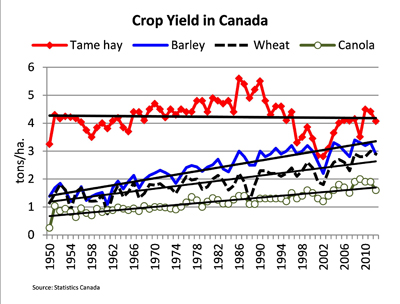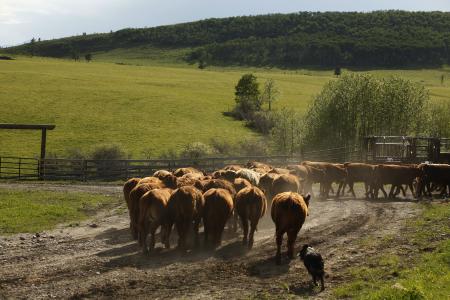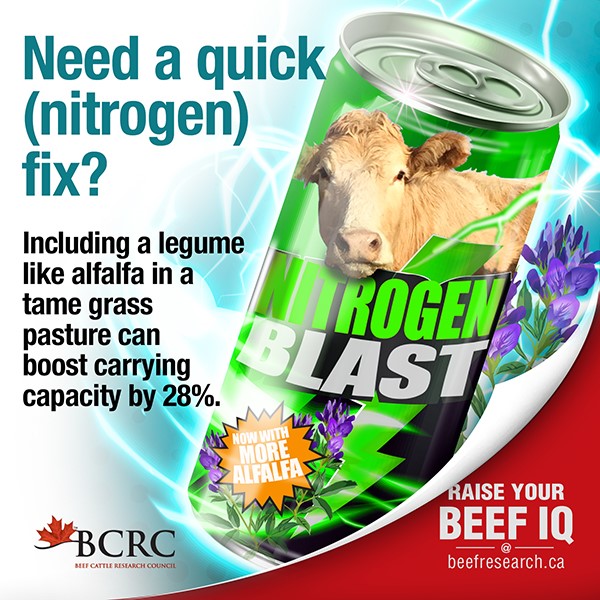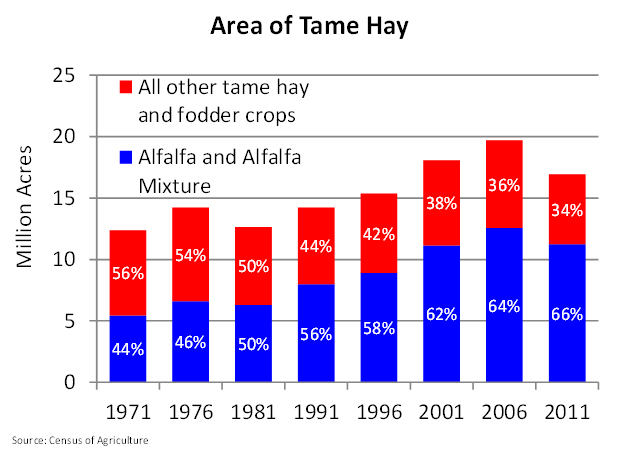Although excellent forage varieties are available in Canada, they may not be performing to their full potential. Factors that limit forage yield potential include weather, soil type and conditions and nutrient availability. While some factors are out of your hands to control, producers can make an impact on soil fertility, pH and drainage. The higher costs for solutions to these issues can be one of the greatest limitations in why they are not implemented on more forage and pasture acres across Canada. Instead, farmers overcome the need for more forage by buying in feed from off farm or renting or buying additional pasture. As the value of land increases, the productivity of that land becomes even more critical.
| Key Points |
|---|
| Nutrient deficiency in soil is one of the important factors limiting forage productivity in Canada. |
| Yield response to fertilizer is unpredictable. |
| Fertilizer efficiency is impacted by soil pH with more acidic soils leading to less efficient fertilizers. |
| The profitability of fertilizing forage crops is highly variable. The feasibility can depend on the cost of fertilizer, cost of soil neutralizing amendments, hay prices, replacement feed costs and land value. |
| A cost-effective way to increase forage yields is to add legumes, including alfalfa, to a stand or seeding mix. |
| Bale grazing systems have the potential to improve soil nutrient levels, hay quality and forage yield. |
| Research on forage varieties with higher yields and longer stand life is ongoing but more is needed. |
Importance of Improving Forage Yields for the Cattle Industry
Note: this webpage has a greater focus on hay production for winter feed. Grazing management can also improve forage productivity over time and is another significant area of research.

Canada’s cow-calf sector is at a competitive disadvantage internationally because of a relatively higher per unit cost of forage ($/tonne) compared to other countries (source: agri benchmark study 2013). Hay yields in Canada have been steady over the past 60 years, while annual crops have had significant yield improvements.
By increasing forage production on grazing land, higher stocking rates can be used and animal performance may improve. Increasing production on hay land reduces the cost of unit of production, which means reduced winter feed costs per cow.
Over the long term, improving forage productivity is crucial for future competitiveness of the cattle industry. While it may be more profitable for a producer to obtain additional hay or pasture from another source in the short term (i.e. buying or renting more land, or purchasing hay), reducing the per unit cost of production is necessary over the long term. Current competition for land from other crops and urban development is putting further pressure on the forage industry to increase margins or risk being converted into a more profitable commodity.
Moisture and soil fertility are essential factors that affect forage productivity and management strategies.
Soil Fertility and Forage Yields
Nutrient deficiency in soil is an important factor limiting forage productivity in Canada. Forages are generally grown on marginal land and their production can be increased significantly with fertilization (Malhi et al. 2004). Forages remove more nutrients from the soil than other crops because more biomass is harvested. However, current application of fertilizer on forages in Canada is minimal; it is estimated that only 25% of the improved pasture and hay is fertilized and only 15% of alfalfa hay fields is fertilized. Given the level of nutrient removal by forages and these low levels of fertilization, it is little wonder that forage stands are only maintained for 3-5 years in high moisture regions of western Canada and 6-9 years in semi-arid regions. In Eastern Canada, stand longevity for improved cultivars is around 3-5 years on more intensively managed cutting systems but may be longer with less intensive systems. Thinning stands, weed encroachment and replacement of introduced forages by naturalized species are common reasons for short lifespans of stands.
Low forage yield is the most commonly cited reason for terminating a stand. Rather than terminating the stand through tillage and reseeding, rejuvenation by fertilization may be the most economic and practical method to improve production and quality in some situations (Lardner et al. 2002).1 Optimum levels of forage production require adequate levels of soil nitrogen (N), phosphorus (P), potassium (K), and sulphur (S) as well as micronutrients. In some areas of Eastern Canada soil pH is a significant concern as more acidic soils impact nutrient availability and lowers fertilizer efficiency. Without the addition of a limiting agent to neutralize soil pH, producers need to apply greater volumes of nutrients to their fields to overcome less efficient fertilizers. For example, the efficiency of N, P and potash in a soil with a pH of 6.0 decreases from 89%, 52% and 100%, respectively, to 77%, 48% and 77% in a soil with a pH of 5.510.
It is recommended to do soil testing to determine soil pH levels and identify what nutrients are limiting. Depending on the limiting agent, it is also recommended to complete soil tests yearly after application to assess the changes in soil pH. Read this blog post to learn more on the influence of soil pH on forage production.
Impact of Moisture on Forage Stands
Uncertainty about moisture conditions discourages fertilizer use as dry conditions can result in volatilization (i.e. evaporation of N) and a limited production response, while very wet conditions can result in water runoff and nutrient leaching, causing environmental concerns and wasted money. Studies show that forage response to fertilizer application is directly related to the amount and distribution of growing season precipitation and the ability of the soil to store water. This has resulted in wide variability in yield responses to recommended fertilizer rates. Producers should follow local recommendations for fertilizer use which may change depending on the soil test results, production system and the ratio of legumes to grasses within the field or pasture.

A 10-year study in Manitoba shows adding fertilizer increased productivity of grass pastures.2 Fertilizer was applied to full soil test recommendation, however the target forage yield was often not achieved due to moisture limitations. Soil can have a significant impact, as very low water holding capacity (such as that found on sandy loam soil) limits moisture availability severely reducing plant growth, forage quality, stocking rate, and animal gain as well as reducing the benefit of fertilizer.
Malhi (2004) showed that the timeliness of rainfall during the growing season can significantly affect productivity. A 19 year study on thin Black Chernozemic soil at Crossfield, Alberta had lower dry matter yield and limited response to applied N in many years. This appeared to be at least partially associated with a lack of timely rainfall.3 A lack of moisture availability has historically been less of an issue in Eastern Canada however extreme weather leading to drought or flooded fields are becoming an increasing concern. Producers may need to become more adaptable in their operations and reconsider harvest timings and storage systems if extreme moisture conditions become more frequent.
Improving Yields of Legume-Grass Mix Forage Stands

Grasses are often sown in mixture with legumes like alfalfa, clover or birdsfoot trefoil. The use of legumes can provide more consistent production throughout a season and improve total yields and forage quality. Many legumes are more productive than cool season grasses during the hot and dry conditions found in mid- to late- summer as the grasses become dormant. Legumes are also typically higher in protein content than grasses leading to improved forage quality and potentially improved animal gains. When seeding use the correct inoculum for the legume to ensure good establishment and production. Properly inoculated legumes can fix large amounts of N from the atmosphere and consequently, additional N is not normally required to obtain increases in dry matter yield and protein content. While grass:legume mixes may not require as much or any nitrogen, other nutrients such as P and K must still be applied, often in higher quantities, as they can influence stand productivity and longevity of the stand. Responses are affected by soil and climatic conditions.
Research has recommended that due to the high variability in response to fertilizer on tame grass, the most cost-effective way to increase forage yields is to add alfalfa to the mix as it increases productivity without annual application costs.4 This has been widely adopted across the prairies over the past decade as management experience and products have reduced death losses from alfalfa related bloat. Over the past 30 years, the area of alfalfa and alfalfa mixtures as a percentage of total tame hay production steadily increased from 44% in 1971 to 66% in 2011.

Research by Kopp et al. (2003)5 found that on sandy soils in Manitoba, incorporation of alfalfa into grass pastures improved carrying capacity by 28% compared to meadow bromegrass alone, while incorporating alfalfa with fertilization (N,P,K and S) improved carrying capacity by 57%. The alfalfa with fertilization treatment had significant financial risk as it was only a cost-effective strategy when precipitation was sufficient; the alfalfa without fertilization treatment was always a cost-effective approach as it did not entail financial risk.
Research in Eastern Canada has demonstrated the importance of legumes in a stand as a way to improve yield, forage quality and animal productivity compared to grasses along11. The additional protein provided by legumes can decrease the amount of supplemental protein from other sources.
Managing Legume Based Forage Stands
Maintaining a legume stand is one of the challenges in a grass-legume production system. A study in Swift Current, Saskatchewan6 showed that alfalfa and sainfoin plant counts both dropped by 50% over the four year grazing trial. Kopp et al. (2003) also found that the alfalfa percentage in the mix declined from 75.4 – 84.1% to 32.5 – 40.3% over a four year period. Further to this, a study performed in Lévis and Normandin, Québec observed losses in legume content as stands aged. The proportion of birdsfoot trefoil within stands decreased from 38% to 4% in Lévis while Normandin saw stands decrease from 43% to 5% as the stands aged from year 3 to year 5 of the study. In the same study the proportion of alfalfa in stands dropped from 30% to 6% in Lévis and from 33% to 11% in Normandin from year 3 to year 5. The proportion of white clover in stands also decreased during this time period however initial proportions were not high to begin with12.
Although alfalfa is specifically names below, the following management techniques can help to maintain many different legumes in a stand:
- In the spring, wait until alfalfa is three to four inches tall before grazing. After the spring grazing period ends, allow the alfalfa to regrow for about 25 to 40 days before cutting for hay.
- Give adequate rest to the stands based on local growing conditions and recommendations. Frequent harvest or grazing without time for forages to recover reduces their long-term persistence.
- Allow plants rest during September and October, or control grazing to maintain at least 6 to 8 inches of standing alfalfa at all times.
- Avoid reducing stubble height to less than 2 or 3 inches in late fall to help protect alfalfa from winter damage.
- Allow plants to grow without cutting or grazing for at least four to six weeks prior to the first killing frost.
The risk of bloat is another challenge of grazing alfalfa and other legumes. Below are recommendations to reduce the risk of bloat when grazing cattle on legume based forage stands:
- Do not move cattle onto new pasture when it’s wet with heavy dew, rainfall or irrigation water. Grazing legumes when it is wet increases the possibility of bloat, so it’s better to move animals to a new pasture in the afternoon rather than in the morning.
- Never allow animals to stand hungry before turning them to a legume rich pasture, as it can lead to overconsumption of fresh alfalfa and other legumes.
- Wait until alfalfa is in full bloom to graze. Bloat risk is highest when alfalfa is in vegetative to early bloom stages of growth. As alfalfa enters into the full bloom or post bloom stages, soluble protein levels decrease, plant cell walls thicken, lignin content increases, and the rate of digestion of alfalfa in the rumen decreases.
- Do not graze alfalfa for three days to two weeks following a killing frost. Frost may increase the incidence of bloat by rupturing plant cell walls, leading to a high initial rate of digestion. Delay grazing alfalfa until the stands dries. The time required to dehydrate varies by location and weather.
More information about alfalfa management and grazing strategies:
Legume Grazing
BeefResearch.ca
Grazing Alfalfa
Volesky, Jerry D., and Bruce Anderson – Historical Materials from University of Nebraska-Lincoln Extension (1999)
Organic Fertilizer Use in Forage Stands
In addition to chemical fertilizer or composted manure, in-field winter feeding systems are another fertilization strategy to consider. Bale grazing can be a cost-effective winter-feeding option that improves forage productivity. Bale grazing not only deposits nutrients through raw manure, bale waste will also make nutrients available to plants (once soil microbes are done feeding). Bale grazing sites must be rotated to prevent excessive nutrient deposits which can lead to problems.
Video: Fertility Management in Pastures
An experiment7 conducted near Biggar, Saskatchewan on a smooth bromegrass-alfalfa field during 2009-2011 showed that bale grazing has positive impacts on soil and plant nutrients (higher protein in forage). Forage yield for the two-year period following bale grazing was higher than an ungrazed site, then dropped back to historic levels. Other experiments conducted in the Peace Region of Alberta8 and in Clearwater, Manitoba9 also showed improvement in soil fertility, forage yield and quality following bale grazing.
Bale Grazing
When bale grazing, producers should consider animal density and bale placement to ensure the optimum deposit rate of nutrients from manure, urine and leftover material and avoid excessive nutrient buildup. Bale grazing should also be avoided on environmentally sensitive sites such as on high water tables, on sandy soil, or in riparian zones where runoff will flow directly into surface water.
For more information about bale grazing management and cost/benefit analysis:
Extended Grazing
BeefResearch.ca
Bale Grazing Calculator
Saskatchewan Ministry of Agriculture
Economics Considerations for Improving Forage Yields
Research has indicated that fertilization can bring the productivity of a stand back to its original level without the expense of re-seeding. However, even when fertilizer is applied at recommended rates, the target yields are often not achieved, making it a risky proposition. Producers working on more acidic soils also need to account for less efficient fertilizers and the additional cost of neutralizing soil amendments (purchase of and application to the land). The goal of fertilizing is to decrease the per unit cost of production. Higher yields do not necessarily translate into lower costs or increased profits. Only when the value of the additional production surpasses the cost of application does it reduce the per unit cost of production and increase margins. The profitability of fertilizing forage crops is highly variable and depends on the cost of the fertilizer and hay prices. As these factors change, so will the feasibility of fertilizing.
Forage fertilization must compete economically with alternative sources such as rented or purchased pasture, purchasing hay or incorporating alfalfa and other legumes in the seeding mix. However, buying more land leaves the per unit cost of production the same and therefore does not add to one’s margin or long term sustainability. As more marginal land is converted to annual crops and land prices increase, the productivity on land becomes more critical. As land prices increase, greater investments into that land to intensify production and increase revenues from the same land base by becoming more efficient with existing resources are more easily justified. Knowing the per unit cost of production on hay ($/tonne)is key to determining the price at which buying hay is the economical choice.
Numerous researchers in the past forty years have studied the effectiveness of fertilization on forage production, however the variability in response means a well-developed yield response model is not available. Without standard yield responses, economic analyses in this area are lagging behind annual crops. Within the limited amount of economic analyses, there is no strong evidence for economic benefit of fertilizing forage crops, especially on grass-legume mixtures.
Learn more about the economics and see simulations of the economic impacts of fertilization and the optimum fertilization rates under different price scenarios in this fact sheet:
Historical review of forage fertilization research
(/research/historical-review-of-fertilizing-forages-research-169)
Conclusions
Forage response to fertilizer as a management strategy vary widely based on the stand composition, soil fertility, soil pH and moisture conditions throughout the growing season with timing of moisture being more important than quantity. Due to this wide variety, longer term studies have provided different results than short term studies.
The goal of fertilizing is to decrease the per unit cost of producing forage. Higher yields do not necessarily translate into lower costs or increased profits due to fertilizer and/or soil neutralizing agents and their application costs. Optimal fertilizer costs are affected by hay prices, fertilizer prices and the base land cost. As hay prices, replacement feed or land base costs increase the willingness to pay for fertilizer should increase. Therefore, it is important for producers to know their cost of production and adjust their strategy based on the current price situation.
In addition to chemical fertilizer, forage productivity could also be improved by sowing mixed grass-legume stands, adding legumes into a stand, using the appropriate inocculant for the legume at the time of seeding or using in-field winter feeding systems. While these strategies bare less financial risk as they are less affected by weather and input prices, good management techniques are required to ensure high yields and environmental sustainability.
- References
-
1 Alberta Agriculture and Rural Development, Fertilizing Grass for Hay and Pasture, http://www1.agric.gov.ab.ca/$department/deptdocs.nsf/all/agdex10473 (Last accessed: August 29,2013)
2 Khakbazan, M., et al. “Economic effects and energy use efficiency of incorporating alfalfa and fertilizer into grass-based pasture systems.” World Academy of Science, Engineering and Technology 49 (2009): 79-84.
3 Malhi, S. S., et al. “Fertilizer management of forage crops in the Canadian Great Plains.” Recent Res Dev Crop Sci 1 (2004): 237-71.
4 M. Khakbazan et. al. 2009. “Economic effects and Energy Use Efficiency of incorporating Alfalfa and Fertilizer into Grass-based Pasture Systems”. Proceeding of World Academy of Science, Engineering and Technology Volume 37 January 2009 ISSN 2070-3740.
5 Kopp, J. C., W. P. McCaughey, and K. M. Wittenberg. “Yield, quality and cost effectiveness of using fertilizer and/or alfalfa to improve meadow bromegrass pastures.” Canadian journal of animal science 83.2 (2003): 291-298.
6 BCRC Project by Dr. Alan Iwaasa, 2006. “Carbon sequestration, methane production and nitrous oxide emissions from cattle grazing native prairie” http://www.beefresearch.ca/factsheet.cfm/pasture-management-and-productivity-56 (Last accessed: Nov 25, 2013 )
7 Saskatchewan forage Council, Nutrient and Yield Effect of Bale Grazing on Hay Fields Project final report
http://www.saskforage.ca/Coy%20Folder/Projects/ADOPT/Bale_Grazing_(ADOPT)-Final_Report.pdf (Last accessed: Nov 25, 2013)
8 Omokanye, A. T. “Soil Nutrient Trends and Forage Production Following Years of Bale Grazing in Parts of the Peace Region of Alberta, Canada.” (2013).
9 Réjean Picard “Nutrient cycling in winter grazing cattle on pasture; three years following bale grazing”, http://umanitoba.ca/faculties/afs/agronomists_conf/media/Rejean_Picard_bale_grazing.pdf (Last accessed: Nov 25, 2013)
10 Advisory Committee on Soil Fertility. Atlantic soils need lime. Publication No. 534-584, Agdex No. 534. Atlantic Provinces Agricultural Services Coordinating Committee.
11 Papadoloulos, Y.A., Kunelius, H.T., and Fredeen, A.H. 1993. Factors influencing pasture productivity in Atlantic Canada. Can. J. Anim. Sci. 73(4), 699-713. Available here: https://doi.org/10.4141/cjas93-076
12 Bélanger, G., Tremblay, G. F., Papadopoulos, Y. A., Duynisveld, J., Lajeunesse, J., Lafrenière, C., & Fillmore, S. A. E. (2018). Yield and nutritive value of binary legume–grass mixtures under grazing or frequent cutting. Canadian Journal of Plant Science, 98(2), 395–407. Available here: https://doi.org/10.1139/cjps-2017-0183
Feedback
Feedback and questions on the content of this page are welcome. Please e-mail us at [email protected].
This content was last reviewed April 2024.
